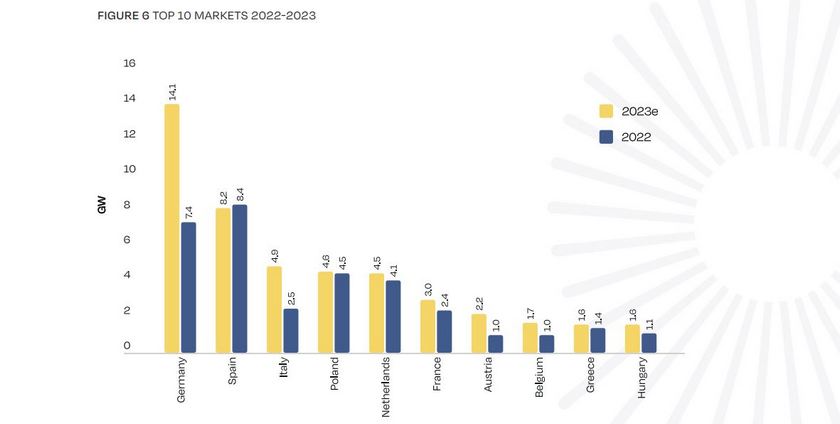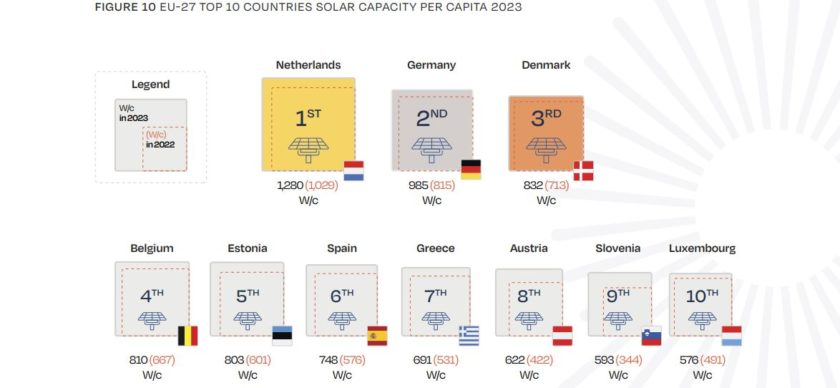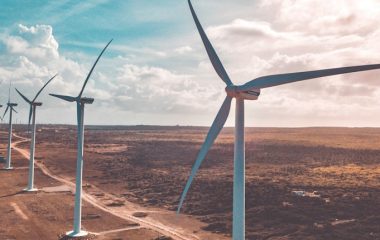
Photo: SolarPower Europe
Share
Share
This year has seen a record 55.9 GW of new solar installations in Europe, a 40% increase against 2022, according to a new report by SolarPower Europe. This is also the third year in a row with an annual growth rate of at least 40%, the report said, but warned that solar capacity additions in 2024 are seen slowing down significantly.
The total solar capacity in the European Union (EU) now amounts to 263 GW, up 27% from the 207 GW in 2022, according to the European Market Outlook for Solar Power 2023-2027, published by SolarPower Europe.
The growth this year was largely due to the lingering impact of the energy crisis and delayed 2022 installations, with the final months of 2023 much quieter than the start of the year, the report notes. In 2024, the year-on-year growth rate is expected to be just 11%, translating into 62 GW of new solar power capacity in Europe.
The 55.9 GW of new solar in 2023 enabled almost 17 million more European homes to be powered by this energy source, SolarPower Europe said in a press release.
At the same time, it almost met the 60 GW target recommended by the International Energy Agency (IEA) in order to offset the phaseout of Russian gas.
“Solar has continued to deliver for Europe in crisis with record-breaking installations. Now as solar hits its own turning point, Europe must deliver for solar. We are not yet installing the average 70 GW annually needed to meet our 2030 solar targets. It’s clear policymakers can’t afford to be complacent for the rest of the decade,” said Walburga Hemetsberger, CEO of SolarPower Europe.
Since the beginning of 2023, Germany has installed 14.1 GW of new solar capacity, taking the top spot in the European rankings. The runner-up is Spain, with 8.2 GW, followed by Italy (4.8 GW), Poland (4.6 GW), and the Netherlands (4.1 GW).

Source: SolarPower Europe
Bulgaria and Romania join group of GW-scale markets
In 2023, 14 EU members installed more than 1 GW of solar in a year, with two countries from the region tracked by Balkan Green Energy News making the list for the first time – Bulgaria and Romania.
Bulgaria is set to end 2023 with nearly 3 GW of total installed PV capacity, putting it on track to achieve its 3.2 GW target for 2030 about seven years ahead of schedule, the report notes. Interestingly, Bulgaria has almost tripled its installed solar capacity in about three years, from just over 1 GW in 2020.
In Romania, the 1 GW of new solar capacity installed this year represents a 308% surge against the new capacity deployed in 2022. In 2023, the country’s cumulative photovoltaic capacity – distributed and utility-scale – has reached 2.85 GW, generating over 2.5 TWh or about 5% of the total electricity output.
The report also compared national solar power targets with SolarPower Europe’s most-likely scenario projections until the end of the decade.
Croatia currently has 0.5 GW of solar capacity, while its National Energy and Climate Plan (NECP) foresees a total deployment of slightly under 1 GW of solar by 2030. However, this is far below SolarPower Europe’s medium scenario projection, whereby Croatia would have 5.7 GW, the report notes.
Southeastern European countries’ targets for 2030 are far below SolarPower Europe’s projections
Greece’s total installed PV capacity is 7.2 GW, and its NECP targets 13.4 GW installed by 2030. This is also well below SolarPower Europe’s projection for the country, 29.6 GW by 2030. This year, Greece installed between 1.6 GW and 1.7 GW of new PV capacity, taking the ninth spot on the list of top 10 markets for 2022-2023.
Greece also ranks 7th on the list of top ten EU countries by installed solar power per capita, with 691 W/c, ahead of Austria, Slovenia, and Luxembourg. The top three places are held by the Netherlands, Germany and Denmark.

Source: SolarPower Europe
When it comes to Cyprus, its NECP foresees a total capacity of 869 MW in 2030, up from 600 MW currently, while SolarPower Europe’s scenario envisages the deployment of 2.8 GW by the end of the decade.
Romania expects a total capacity of 8.3 GW by 2030, while SolarPower Europe’s scenario envisages installing 20.7 GW by that year.
In Slovenia, the NECP foresees a contribution to gross final energy use of 3.861 GWh by 2030, which would correspond to about 3.1 GW of installed capacity. On the other hand, SolarPower Europe’s scenario projection for Slovenia is 6.2 GW.
When it comes to solar power per capita, Slovenia has entered the top ten list this year, taking the 9th spot with 593 W/c, a 72% increase from 2022 and the highest rise in Europe.
EU’s rooftop solar market soars 54% as utility-scale PV shows sluggish growth
The report also analyzed the rooftop and utility-scale solar trends, as well as the manufacture of solar cells, modules and other equipment.
The rooftop solar market in the EU expanded 54% from 2022, driven by commercial and industrial customers. On the other hand, the market share of utility-scale solar declined 6% for a number of reasons, such as delayed auctions, higher grid fees, inflation, and permitting and grid connection issues.
Overall, new utility-scale solar in Europe reached 19 GW in 2023, up from 16 GW in 2022. On the other hand, rooftop solar grew from 24 GW in 2022 to 37 GW in 2023.
The report also notes that solar cell manufacturing in the EU has grown from 1.4 GW to 2 GW in 2023, while module production soared 59% to 14.6 GW. However, less than 2% of Europe’s current demand for solar could be met with European-produced solar PV, according to the report.









Be the first one to comment on this article.